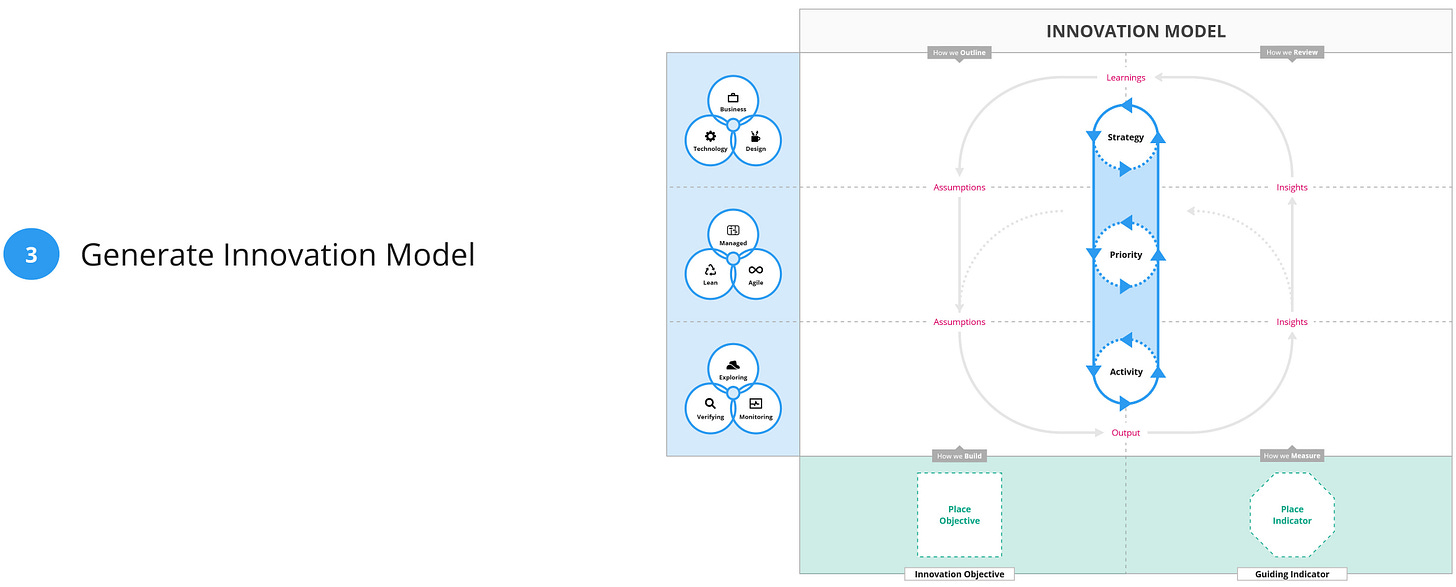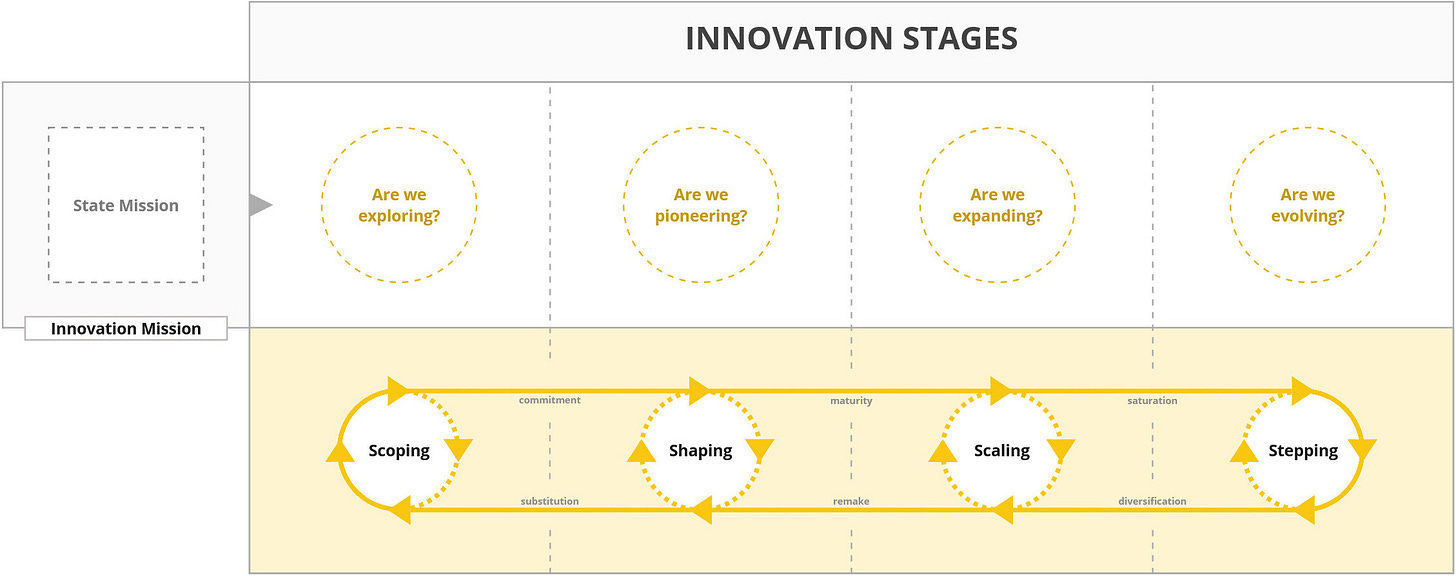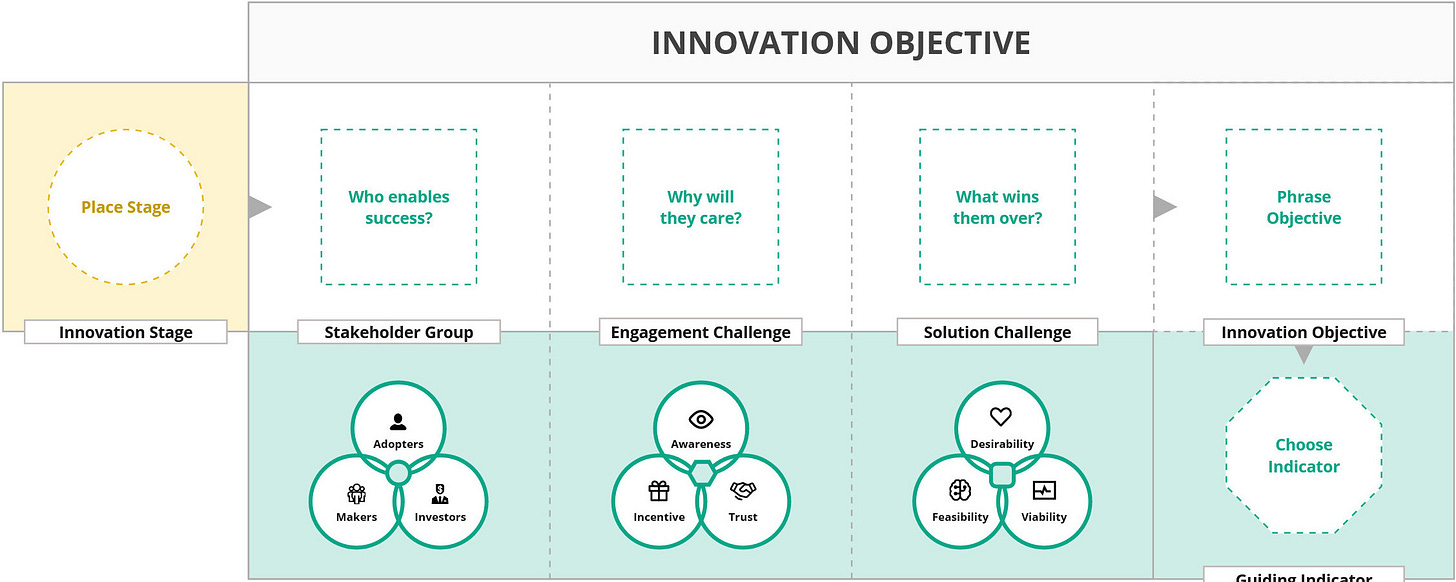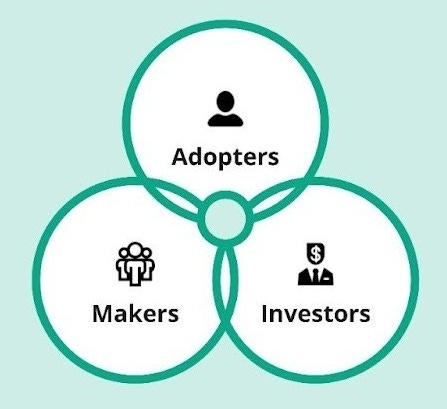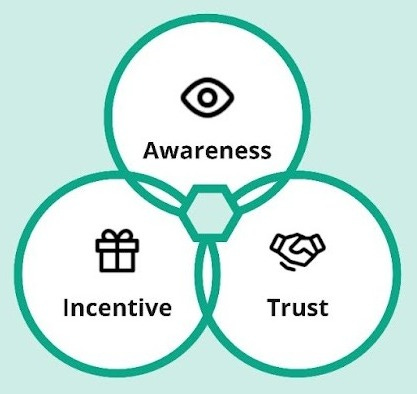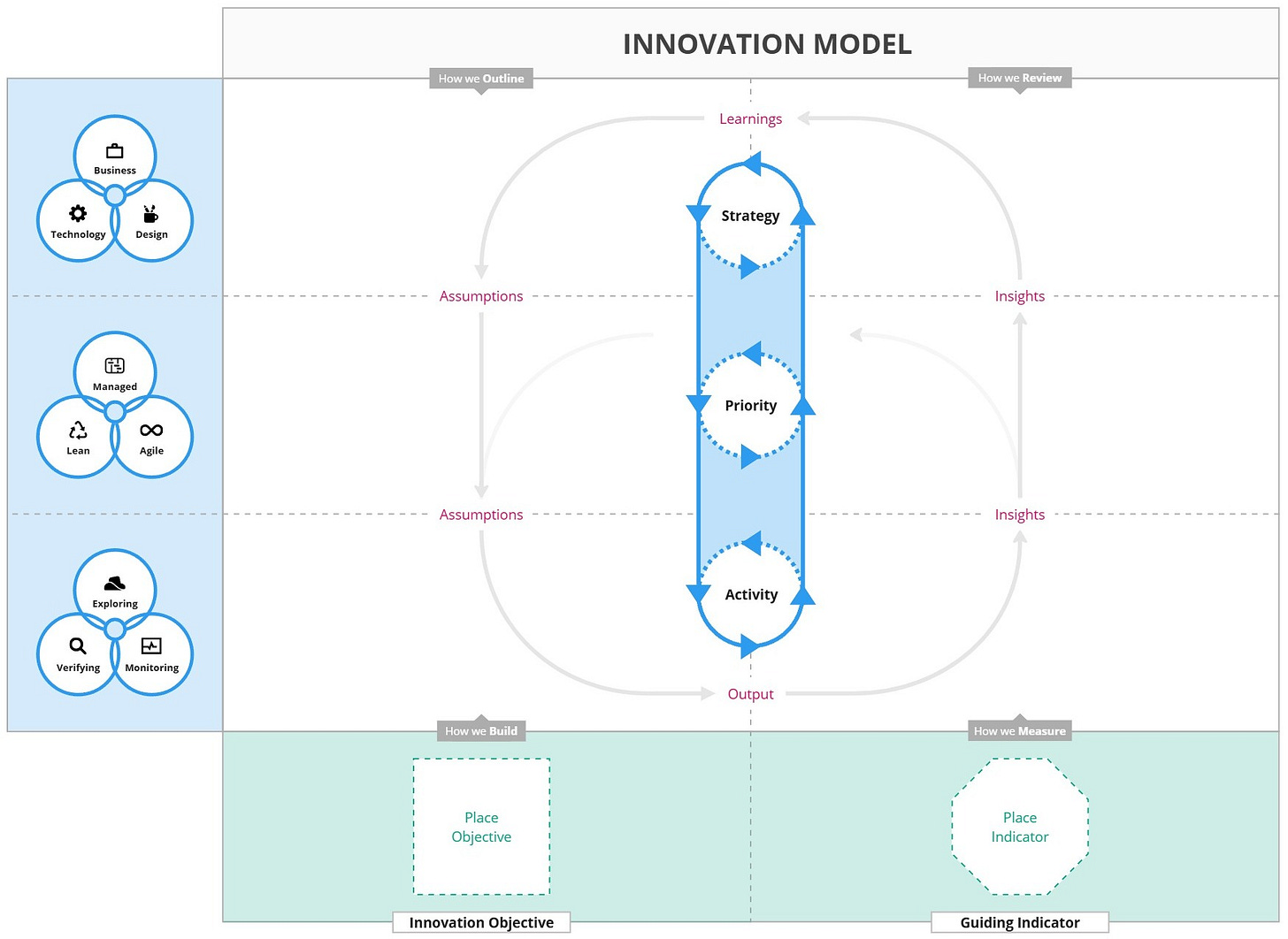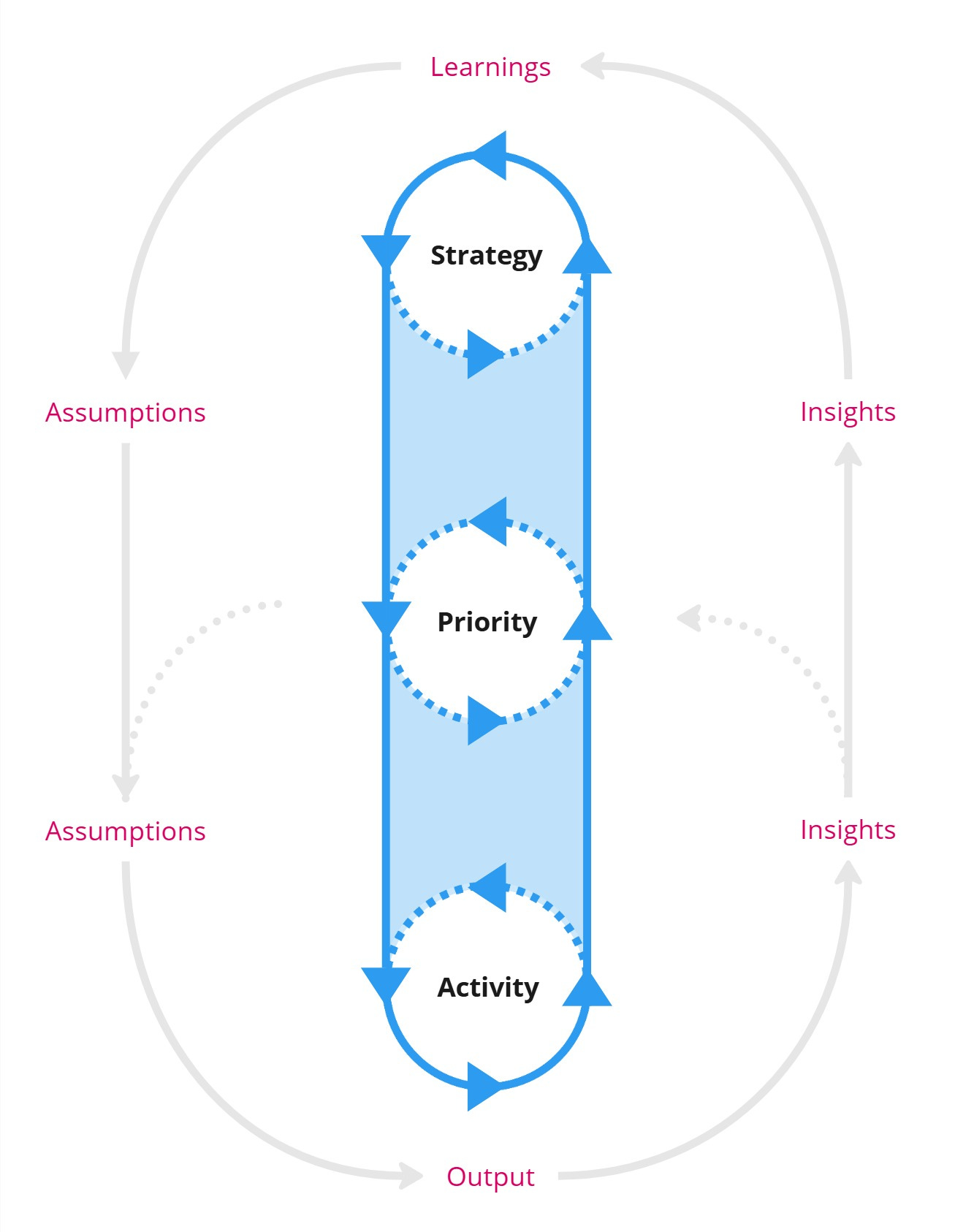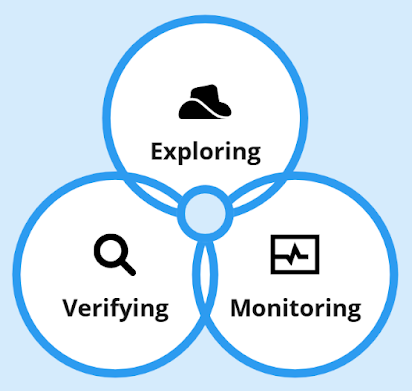Developing Effective Innovation Models
A guide to Adaptive Innovation: Part 2 of 3
In our introduction to Adaptive Innovation, we explored the merits and limitations of some of the best-known methods for effective innovation. We summarized their major blind spots, in isolation and combination with each other, to now sketch out a structured approach to fill these gaps.
Adaptive Innovation is designed to be useful to organizations of any size, industry, or purpose and applies to innovation processes beyond the development of commercial products. To help innovators accomplish their mission, we developed a series of interconnected canvases that we explain in detail throughout this guide.
In a Nutshell
We divide the development of effective innovation models in three steps:
What defines success, greatly depends on how mature an innovation is. For that reason, we divide the innovation journey into different innovation stages. Each stage adds a different context to innovation objectives and consequently suggests substantially different methods to achieve them.
The innovation objectives provide a systematic approach for innovators to define innovation success for the various innovation stakeholders in the context of their current innovation stage along the innovation journey. The combined results are innovation objectives that are later used to structure the innovation model.
The innovation model helps innovators outline and formalize how they intend to reach their innovation objectives. For each innovation objective, innovators generate and regularly update their innovation model. It describes how learning and communication shape the validation process and how assumptions are systematically turned into insights.
Step 1: Identify Innovation Stage
The Innovation Journey
Every innovation starts with a mission that the innovation aims to achieve. This mission could solve a problem, improve a process, create a new market, or meet a specific need. However, fulfilling this mission is rarely a straightforward process. It often involves a long and complex journey with numerous challenges and obstacles.
The innovation journey is composed of multiple, distinct stages that all require a different way of thinking about the innovation process and its objectives. While it might seem straightforward, identifying and agreeing upon the specific stage a team or organization currently occupies is often a source of confusion and disagreement.
This misalignment can create significant challenges, as a shared understanding of the current stage is essential for establishing a unified vision and aligning innovation objectives. Without this clarity, teams may find themselves working at cross-purposes, pursuing conflicting goals, or investing resources in initiatives that are misaligned with the organization's current needs and priorities.
Therefore first things first: We want to make sure that everyone is aligned within an organization with regard to where it is located within its journey.
Stages of Innovation
Scoping
Starting with the scoping stage, innovators compare competing ideas that will lead to substantially different strategies. This stage is characterized by a mix of open-minded ideation and exploration. Here, the compared innovation strategies can represent fundamentally different approaches, including different missions, visions, values, and business models. Solutions can be and oftentimes should be prototyped here, but only with the goal of exploring assumptions so critical that they are considered prerequisites of success during later stages.
Shaping
The shaping stage starts when innovators have made their choice and committed to an idea. The entry into this stage is characterized by manifesting the ‘what’ with everything from prototypes to full-blown pilots. Development here moves from establishing fundamentals to an exploration of important implementation details. The shaping stage concludes with a solution that has proven worthwhile to a niche, early adopters, lead customers, or a test group.
Scaling
The scaling stage starts when a solution that already fares well in a small community is set to grow to a wider audience. Oftentimes, what worked for that small group, does not work for a wider audience without modifications and adaptations. Once a solution gains traction with a diverse audience, its adoption is often boosted through effective communication and incentives, commonly achieved through marketing or sales campaigns.
Stepping
Evolution kicks in when a solution has reached a point of satisfaction where new adopters cannot be effectively activated anymore in large quantities. Opportunities and challenges are now generated by continuous learning in an ever-changing world. Innovation can continue to achieve impressive results at this stage, continuously building on prior achievements. In fact, a lot of today’s crucial high-tech products have been the result of many increments on the same base concept.
From linear to cyclic
It’s important to note that the innovation journey is not linear but circular for two reasons:
Established market leaders with innovations in the evolution stage will not just wait and watch how new competitors take over their market with a novel and superior approach. They will regularly find themselves in a situation where they need to consider the diversification, remake, or substitution of existing solutions.
Despite best efforts, innovators in the scaling or shaping phase can come to realize that they have to take one or several steps back. Sometimes, fundamental issues with a solution are only figured out during the attempt of implementation or when trying to scale it. In such cases, it is not uncommon for innovators to return to an earlier stage of innovation.
However, every shift between stages needs to come with a change in perspective as the core challenges are vastly different at every stage of innovation and so are the tools and activities that support innovation.
This is very important for us to point out because a major pitfall that innovators need to avoid is moving from one stage to another (in any direction) while failing to acknowledge the implications on tools, processes, mindset, etc.
The innovation stage provides crucial context for the generation of innovation objectives. Therefore, properly identifying the current innovation stage is a precondition to innovation success.
Step 2: Define Innovation Objectives
Innovation Success
The goal of every individual step on the innovation journey is to reduce uncertainty and increase the likelihood of success. For that, innovators need to eliminate paths with unjustifiable risks and low impact while identifying paths with manageable risks and high impact. To find and stay on a reasonably promising path with confidence, innovators require indicators that they are making progress in the right direction.
While without a doubt hundreds of such domain-specific indicators exist, compiling them into a gigantic list won’t be practical. Instead, we want to present a generic approach to defining innovation objectives through a set of perspectives that are critical to all innovation, and at the same time open to interpretation, refinement, and extension. We call these perspectives aspects of innovation success.
While in itself each aspect represents a very broad perspective on innovation success, combining aspects from different perspectives allows innovators to phrase concise innovation objectives. Innovators can then identify the most relevant domain-specific guiding indicators for an innovation objective and therefore explain how innovation success and therefore progress is measured.
To get started, we suggest composing innovation objectives using the following aspects of innovation success, grouped by independent perspectives:
Aspects of Innovation Success
Stakeholder Groups
Stakeholder groups represent different aspirations that people and organizations connect with an innovation initiative. Any initiative will only be successful in the long run when the goals of all relevant stakeholder groups are met.
Adopters are any actors that innovators need to win over with their innovation, e.g. buyers, customers, users, etc. who value empathy for their needs and an adequate solution for their problems and desires.
Makers are the innovating organization itself, their strategic partners and suppliers, and really anyone actively working towards the same innovation mission, achieving a vision in alignment with their values while being financially successful.
Investors are any financiers of the innovation like a bank offering a loan, VCs funding a startup, or a budget committee financing projects within a corporation. Whoever the investors are, they will want to maximize their return on investment while minimizing their risk.
When defining an innovation objective, starting with the stakeholder groups is relatively straightforward: Whose aspirations am I addressing with an innovation objective? Whose perspective am I catering to? Who am I generating insights about?
Engagement Challenges
The engagement challenges highlight the conditions for innovation stakeholders to engage with a solution. When any of these conditions are not met for a group of stakeholders, they will refuse to invest their time, money, or energy into a solution.
Awareness is the ability of stakeholders to find and evaluate an innovation.
Incentive is the reason for a stakeholder to invest effort (time, money, energy) when engaging with an innovation.
Trust is the level of confidence stakeholders have in the realization of innovation and the benefits it promises.
All engagement challenges pair well with all innovation stakeholders. An innovation needs to be visible to all relevant stakeholders to even consider an engagement. Adopters, Investors, and Makers all need to see the benefit of engaging with an innovation. And fruitful partnerships among Makers require just as much trust-building as engagements with Investors and Adopters, all looking for a track record of success or even solid proof in some cases. The difficult part is to uncover which innovation stakeholder is facing the most critical engagement challenge.
Solution Challenges
Solution challenges describe the prerequisites for any concrete solution to see the light of day. When these conditions are not met, an innovation will not be able to deliver its promises.
Desirability describes the acceptance of a solution with the target group and answers the question “How will it be useful?”
Viability covers financial goals like profitability as well as access to necessary resources (natural, human, capital) and answers the question “How will it be sustained?”
Feasibility focuses on whether all technological, regulatory, and similar challenges can be overcome and answers the question “How will it be achieved?”
The relationship between stakeholders and solution aspects is usually quite straightforward but we recommend thinking beyond the obvious. While desirability typically focuses on adopters like users and buyers, viability can concern every stakeholder: in an online marketplace like eBay, viability is not only a concern of makers and investors but also to sellers and therefore adopters. Feasibility will always be top of mind for makers and investors, however, in some cases, it can again become the concern of adopters, for example, when users are wondering if a promised security standard is false marketing or actually achievable.
Guiding Indicator
To make the innovation objective tangible, it’s now time to identify the best possible observable guiding indicator for that objective. Ideally, such an indicator is an objective, precise, and quantitative metric, but sometimes qualitative indicators are going to be the best available choice. Some prioritization tools will make suggestions for such guiding indicators. (e.g. Pirate KPIs and OMTM) and we encourage innovators to explore these tools together with the identification of the guiding indicator.
Once a guiding indicator is established, innovators gain strong guidance with regard to validation tooling while generating the Innovation Model. Also, the indicator will keep being relevant when working with the innovation journal.
Without systematically defining innovation success, innovators risk cultivating biases and start making implicit assumptions without realizing. Defining relevant innovation objectives is the prerequisite for generating effective innovation models.
Step 3: Generate Innovation Model
Validation at the Core
With innovation success expressed in a concise way through innovation objectives, we can now bring the innovation framework to life. For that, we are going to define innovation models for each innovation objective. Here we will explore how to enact validation with the most relevant tools and activities, while never losing direction.
The goal here is to connect the key validation tools and activities, illustrating a constant flow of knowledge: assumptions are the foundation of what we research, make, or build. The resulting output is what we use to generate valuable insights through measurement and feedback. And finally, by communicating these insights across different levels, we can generate validated learnings that in turn become the foundation of more sophisticated assumptions.
The validation process is the driving force behind reliable innovation progress across all types of organizations, sectors, and industries. The validation process informs innovators whether they are on track to reach their innovation objectives. It describes a continuous flow of information that can broadly be described as assumptions turned into insights within a mind, team, or organization. Only when insights reference prior assumptions and new assumptions are built on fresh insights, does an innovation process effectively generate progress.
This reflects a generalizable experience that numerous innovators have demonstrated and that is also emphasized by the Lean Startup methodology: when innovators actively confront themselves about what they believe they know and what they actually know, they are more likely to challenge risky assumptions early during the validation process.
In startups with the size of a team, it is this mindset in combination with proper validation practices that generates effective innovation progress. As the most relevant information about assumptions and insights oftentimes flows naturally between team members, startups have a solid chance to get it right intuitively.
However, the more decision-making becomes distributed as the organization grows, the more explicit attention needs to be paid to this critical flow of information. While different forms of organization and collaboration will encourage or discourage information flow, there is no simple recipe for how to structure large organizations to become more or less innovative.
We therefore focus on describing what an effective validation process looks like, regardless of an organization’s structure or size. For that, we identified three different levels of validation that exist independently of any organizational chart and that can apply to solo entrepreneurs, early-stage startups, mid-sized companies as well as very large organizations like corporations and government bodies: Strategy, Priority, Activity.
Levels of Validation
When we apply the idea of systematically turning assumptions into insights to these levels of validation, we end up with a refined perspective on validation that is helpful to all innovators while adding the capability of navigating organizational questions when they arise:
Strategy
Strategy describes how to reach your objectives with the resources at hand. It explains which outcomes are desired and which resources are used to generate the desired outcomes. In contrast to prioritization, strategy does not entail detailed plans or anything else that is subject to frequent change. It is brought to life through visions, models, and concepts.
Business strategy outlines the business model, marketing and sales strategy
Technology strategy describes the technology vision, tech stack, and system design
Design strategy focuses on (product) vision, design concepts, and general user experience
The difficult part of formalizing a strategy is not to define individual sound parts of a strategy but to outline a unified approach. In a wider sense, design outlines what to make, technology clarifies how to implement it, and business explains why there is demand for it and how to address it. All these strategic aspects need to be connected and coherent with each other to be successful in the long-term.
Priority
Priority determines the order of activities while working towards an innovation objective and will greatly determine whether an organization will stay afloat or run out of resources before achieving the objective. The right priorities optimize available resources and reliably secure necessary future resources.
Managed priorities are based on a detailed plan or specific goals for every role
Lean startup prioritizes the elimination of uncertainty through critical assumption testing
Agile’s perspective on priorities is rooted in iterative continuous development and quick adaptations based on feedback and changing circumstances.
Typically, none of these perspectives on priorities is exclusive, but depending on context and culture, an organization will naturally lean heavier towards one than the other. The more important dependencies are, the more managed a process needs to be (e.g. in construction). The higher the uncertainty, the more important it is to think lean (e.g. in deep tech). And the more relevant a stellar user experience is, the more attention needs to be paid to the agile perspective (e.g. in consumer apps).
Activity
Activity is where the rubber meets the road, and assumptions are put to the test. As established earlier, innovators need to constantly validate their approach to increase the odds of reaching their innovation objectives. The general methods of exploring reality need to be evidence-based in order to be valuable.
Exploring fosters the understanding of problems, desires and potential solutions in an open-ended fashion
Verifying focuses on systematically testing a hypothesis or new solution
Monitoring ensures that already developed solutions continue to improve
It’s important to note that every assumption will be put to the test sooner or later, one way or another. The question really is not ‘if’ but ‘when’. When a solution is not performing as expected when monitoring it in production, in many cases the related insights could have already been gathered long before: Through exploring and comparing various approaches early on, or through verifying core concepts in a prototype or pilot before releasing a solution.
Macro vs. Micro Validation
In addition, we need to clarify the dotted circles in the canvas at every level of activity which are more than just a visual detail: they describe iteration within each level.
When defining strategy and priority, iterations on the micro level pull in expertise that is easily accessible without explicit validation efforts. An iteration here can represent an expert meeting, an interdisciplinary workshop, or the review of a study. Yet, the insights generated during these activities can be important to everyone and should be communicated throughout the validation process.
Within the activity level, iterations represent a continuous improvement in implementation and operation. This includes perfecting solutions just as much as improving collaboration and tooling. An iteration here could span a release cycle in software, an optimization cycle in manufacturing, or a refinement cycle in design.
These forms of micro-validation within a level of validation are typically what many organizations have mastered well. And that can actually be a problem: when people focus on obvious and well-understood issues in front of them, they are more likely to overlook less obvious but way more important macro issues. Therefore:
Successful innovators set themselves apart by mastering the validation process holistically from all relevant perspectives, constantly confirming or correcting strategy and priority based on relevant observations from activity.
Putting it all to Practice
In this part of the guide, we have described a canvas for organizations to sketch out how learning and communication establish an effective validation process and how they can actively work toward their innovation objectives.
What we are still missing at this point is a way for innovators to track their day-to-day validation efforts along their innovation journey. The Innovation Journal ties it all together in a continuous effort to monitor the innovation journey. Here innovators document their validation process and track their progress towards innovation objectives.





